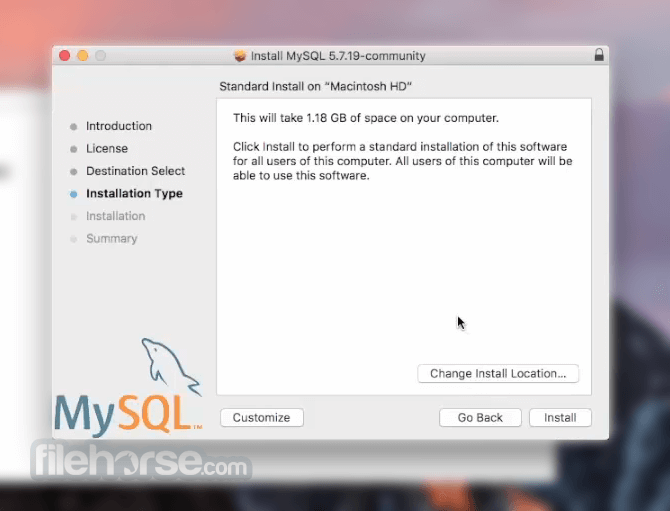

- INSTALL MYSQL MAC TERMINAL BREW MAC OS
- INSTALL MYSQL MAC TERMINAL BREW INSTALL
- INSTALL MYSQL MAC TERMINAL BREW PASSWORD
- INSTALL MYSQL MAC TERMINAL BREW FREE
htaccess within the web server to allow overriding of the Apache config on a per directory basis. In the same block change AllowOverride None to AllowOverride All this will allow the use of. In the examples below replace billyshall with your username.įind DocumentRoot "/Library/WebServer/Documents" and change to DocumentRoot "/Users/billyshall/Sites"
INSTALL MYSQL MAC TERMINAL BREW FREE
Feel free to use vim here if you are 1337 we'll use nano here for simplicity, open the apache config file with the following: $ nano /usr/local/etc/apache2/2.4/nf We can do this by opening Apache's configuration file. We will need to make some changes to Apache's settings so that it works well with this setup. If you need to create the sites folder manually run the following command mkdir ~/Sites or create the folder in finder under your user directory. OSX Lion and later versions do not come with a default Sites folder, the Sites folder disappeared (along with the web sharing toggle in the System Preferences pane) beginning with OS X 10.8 Mountain Lion. Ideally we want to store our websites in the 'Sites' folder under the user account.
INSTALL MYSQL MAC TERMINAL BREW PASSWORD
This step is not required if you would rather, just prefix some of the commands below with sudo and enter your password when prompted.Īpache by default runs out of the /Library/WebServer/Documents/ directory. You will be prompted to enter your user account password, after typing your password, submit by hitting enter. Note: $ sudo su - will allow commands to be run in the root environment so you will not have to type your password after every command. As of OS X Sierra, the php build included is PHP 5.6.x El Capitan ships with PHP 5.5.x and OSX 10.8 Mountain Lion ships with PHP version 5.3.
INSTALL MYSQL MAC TERMINAL BREW INSTALL
After Homebrew is complete, we're going to install the latest version of PHP and Apache. The installation process will take a few minutes to finish. Open terminal and run the following command to install Homebrew: $ sudo launchctl unload -w /System/Library/LaunchDaemons/ 2>/dev/null Let's make sure the default version of Apache is off and will not start automatically at startup.
INSTALL MYSQL MAC TERMINAL BREW MAC OS
Once installed open terminal and run the following command to install the Xcode command line tools:Īpache and PHP have both been included with Mac OS but we will be using the Homebrew package manager so that we don't overwrite any system packages that will be lost upon operating system upgrade. TLDR: If you are impatient or would like a quicker solution without touching the command line, a MAMP GUI installer program can be found here: įirst Xcode and it's command line tools will need to be installed, it can be found on the App Store here: Follow along and you’ll have a MAMP local server environment running on your Mac in no time! MacOS however does not ship preinstalled with MySQL but setup is easy. MAMP refers to a Mac, Apache, MySQL & PHP stack that is typically used for local web development.Īpache and PHP are both bundled with macOS and can easily be enabled by editing a few files. Setup a MAMP local development environment on the latest macOS Tar -xvf ~/Downloads/phpMyAdmin-4.7. Apache, PHP & MySQL on macOS Sierra You can use MySQL through command line but this is a good way to administer MySQL. You can either change permissions like this: chmod 755 directory/ or you can change the ownership of the directory to the apache user and group: chown -R _www:_www directory 5. The Apache user( _www) needs to have access to read, and sometimes write, your web directory. You may recieve 403 forbidden when you visit your local site. Now we need to ensure PHP and MySQL: cd /varĪll your sites would have URLs like pointing to /Library/WebServer/Documents/some-site. Type '\c' to clear the current input statement. Other names may be trademarks of their respective Oracle is a registered trademark of Oracle Corporation and/or itsĪffiliates. Commands end with or \g.Ĭopyright (c) 2000, 2017, Oracle and/or its affiliates. Enter password and then something like this appear: Welcome to the MySQL monitor. It will ask you write the password you set for mysql before. Reload privilege tables now - Choose yesĪfter finishing this up, test MySQL: mysql -uroot -p.Now configure MySQL : mysql_secure_installation Now start MySQL: brew services start mysql Install brew services now: brew tap homebrew/services Now Restart apache: sudo apachectl restart 3.

Now uncomment the following line (Remove #): LoadModule php5_module libexec/apache2/libphp5.so Now edit the nf with vi or any other text editor: vi nf This will help you to cross check later what you changed or in case you want to restore the configuration to default. Let's make a backup of the default Apache configuration.

Open your browser and access If it says It Works, then you are set otherwise see if your apachectl has started or not. Open Terminal and run the following Code: sudo apachectl start


 0 kommentar(er)
0 kommentar(er)
